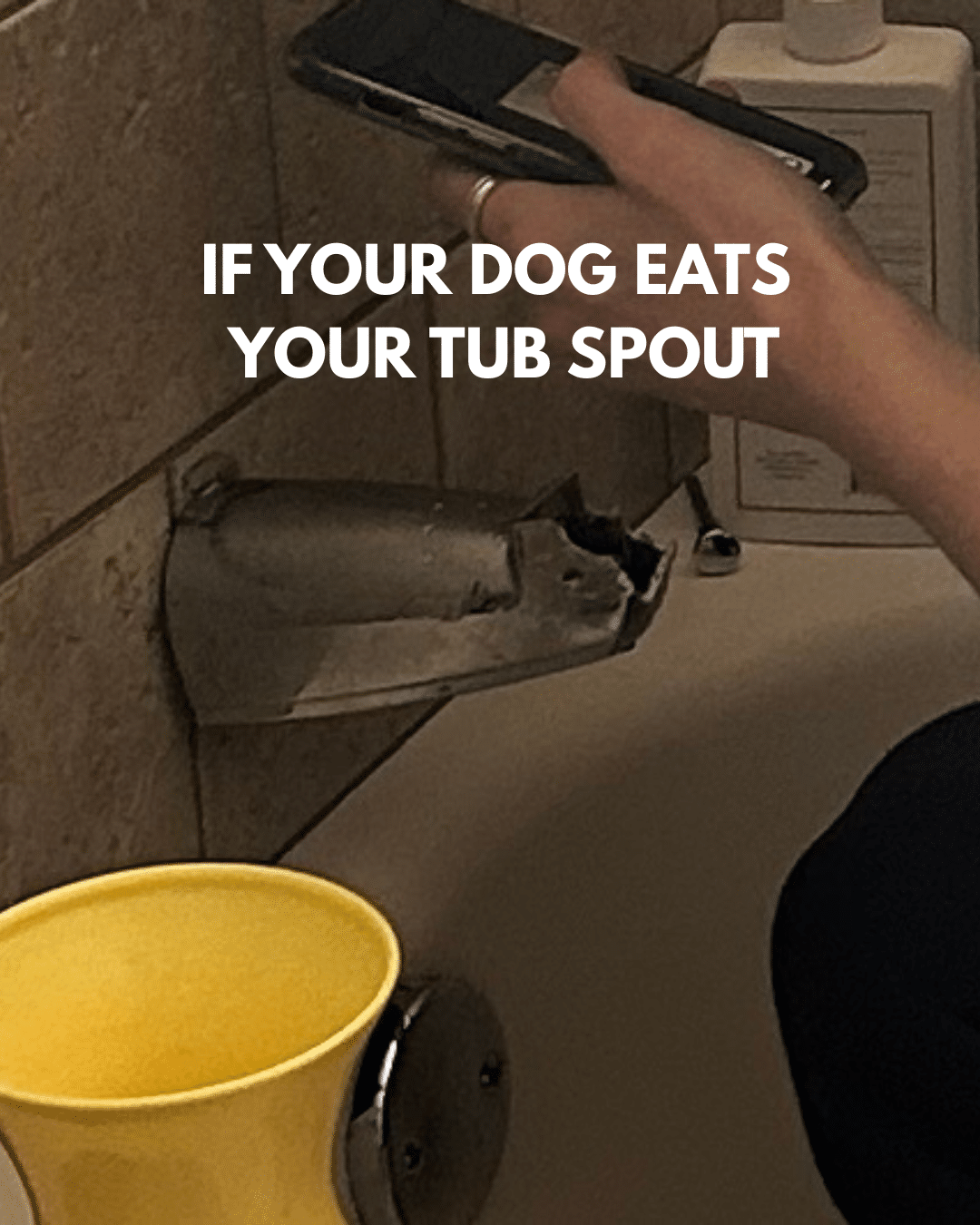If your tub spout is leaking, the cause is almost always one of four things: a worn washer or O-ring, a failing cartridge, a broken diverter, or a loose/corroded connection behind the wall. The fix ranges from a simple spout swap to a valve repair depending on when the leak occurs and where the water is coming from. Minor leaks are DIY-friendly, but anything involving the valve or water behind the wall should be handled by a pro to prevent hidden damage.
This guide walks you through how to diagnose the leak, the most common causes, DIY steps, when you need a plumber, and how much repairs cost in a typical Northeast Ohio home.
Why Your Tub Spout Is Leaking (And What to Do First)
A leaking tub spout isn’t just annoying — it wastes water, raises your utility bill, and can allow moisture to seep behind tile or drywall. Most Cleveland-area homeowners assume they need a full faucet replacement, but in reality, the fix usually comes down to one part:
-
a worn seal
-
a bad cartridge
-
a faulty diverter
-
or a loose connection
Your first step is to identify when the leak happens, because that instantly points you to the right repair.
Quick Diagnosis: What the Leak Is Telling You
If the spout drips after the water is off:
Likely a worn washer/O-ring or failing cartridge.
If water comes from both the showerhead and spout when the shower is on:
The diverter is failing.
If water is leaking at the base of the spout or behind the wall:
Loose connection or corroded pipe.
If the leak changes depending on hot vs. cold:
Cartridge failure.
📊 Symptoms → Cause → Fix (Fast Reference)
| Symptom | Most Likely Cause | Repair Needed | DIY? |
|---|---|---|---|
| Drip when water is off | Worn washer/O-ring or cartridge | Replace O-ring or cartridge | Yes |
| Water leaks only when shower is on | Diverter failure | Replace tub spout with diverter | Yes |
| Water at base of spout | Loose/corroded connection | Remove & reseal spout | Yes |
| Hot side drips more | Cartridge issue | Replace cartridge | Maybe |
| Water damage behind wall | Loose pipe or valve leak | Valve/pipe repair | No |
| White chalky buildup | Hard water damaging seals | Clean or replace parts | Yes |
The 6 Most Common Reasons a Tub Spout Leaks
Below is each cause explained with symptoms, fixes, and when to call a pro.
1. Worn Washer or O-Ring
Inside the faucet are rubber gaskets that create a watertight seal. Cleveland’s hard water wears them down quicker than expected.
Symptoms:
-
Drip continues for minutes or hours after shutting off water
-
Leak gets slightly worse over time
Fix:
Replace the washer or O-ring. Affordable repair kits like the Danco Faucet Repair Kit from Lowe’s give you multiple sizes for most brands.
2. Failing Cartridge or Valve Stem
Single-handle tub faucets use a cartridge that mixes hot and cold. When internal seals break down, water slips past even in the “off” position.
Symptoms:
-
Persistent, steady drip
-
Drip changes when switching hot/cold
-
Hard-to-turn handle
Fix:
Replace the cartridge. A good multipurpose tool for set screws and light drilling is the Kobalt 20V Max Drill Kit, which makes removing stuck screws and reinstalling new parts much smoother.
👉 If you’re not sure which cartridge you have, remove it and take it to Lowe’s — Moen, Delta, and Pfister units vary.
3. Diverter Malfunction
If you pull a knob on your tub spout to activate the shower, the diverter controls water direction.
Symptoms:
-
Water sprays from the showerhead AND pours from the spout
-
Low shower pressure
-
Diverter knob feels loose or sticks
Fix:
Replace the diverter-style tub spout. Be sure to match the type:
-
Slip-on style (tightened with one set screw)
-
Threaded style (screws onto pipe nipple)
A little Teflon tape on threaded models prevents future leaks.
4. Loose or Damaged Spout Connection
Spouts loosen over time — especially in older homes where pipes shift slightly in the wall.
Symptoms:
-
Water running down the wall
-
Water pooling behind the spout
-
Spout wiggles or feels loose
Fix:
Remove the spout, clean threads, apply plumber’s tape, and reinstall.
If the pipe behind the wall is corroded or wobbles? Call a professional before it escalates.
5. High Water Pressure & Hard Water Damage
Many Northeast Ohio homes have water pressure above 70 psi — well over the recommended 55–60 psi.
High pressure + mineral buildup = shredded seals.
Symptoms:
-
Multiple faucets drip
-
White crust around spout
-
Pipes “whistle” when using water
Fix:
Have your home pressure tested. A softener or pressure regulator will extend the life of all plumbing fixtures.
6. Corroded Valve Seat
This is the metal surface the washer presses against to stop water. When it pits or corrodes, no washer can seal it fully.
Symptoms:
-
Drip persists after replacing washers
-
Leak worsens under pressure
Fix:
Valve seat resurfacing or replacement — a job best left to a pro unless you have the tools and time.
🛠️ How to Fix a Leaking Tub Spout (Step-by-Step)
These instructions cover the most common DIY repair: replacing the spout itself.
Step 1 — Shut Off the Water
If your tub has local shutoffs, close them. If not, use the main home shutoff.
Step 2 — Identify Your Spout Type
-
Slip-on: Look for a small screw underneath the spout.
-
Threaded: No screw — it simply unscrews counterclockwise.
Step 3 — Remove the Old Spout
Slip-On:
-
Loosen screw underneath with Allen key
-
Pull straight off the pipe
Threaded:
-
Turn counterclockwise
-
Use a strap wrench if stuck
Step 4 — Clean the Pipe
Remove old silicone or buildup.
Check for corrosion, cracks, or loose pipe movement.
Step 5 — Install the New Spout
Slip-On:
-
Slide onto pipe and tighten set screw
Threaded:
-
Wrap threads with Teflon tape
-
Screw on until snug
-
Adjust alignment
Step 6 — Test for Leaks
Turn water on slowly. If it drips from the base, tighten or re-tape.
👉 For repairs beyond the spout — like diverters, cartridges, or valve seats — call a pro to avoid damaging the wall.
How Much Does It Cost to Fix a Leaking Tub Spout?
DIY Costs
-
Replacement spout: $18–$45
-
Cartridge: $20–$60
-
Teflon tape & tools: $5–$25
Professional Repair Costs in Northeast Ohio
-
Simple spout replacement: $75–$200
-
Cartridge replacement: $150–$250
-
Valve/pipe repair behind the wall: $300–$400+
When homeowners accidentally create a bigger problem:
-
Stripped threads
-
Wrong cartridge installed
-
Broken diverter stem
-
Cracked pipe nipple
That’s when prices jump — because now the wall must be opened.
DIY vs. Hiring a Professional
Great DIY projects:
-
Tub spout replacement
-
Cleaning calcium deposits
-
Replacing simple washers
-
Swapping slip-on diverter spouts
Call a professional when:
-
Water leaks behind the wall
-
Spout won’t tighten or align
-
Valve won’t fully shut off
-
You can’t identify the cartridge
-
The pipe in the wall wiggles
-
Mold or soft drywall appears
Most professional repairs take under an hour, and you avoid hidden damage.
A Real Story (and a Laugh)
One of the funnier calls I’ve ever had wasn’t caused by hard water, corrosion, or a failed cartridge — it was caused by a dog.
A homeowner I regularly work with called me laughing but slightly panicked. Her golden retriever had chewed the end of her tub spout clean off. No washer could fix that one. We replaced the entire spout and tightened the plumbing behind it for good measure.
Whether it’s a worn seal or a bored dog, the fix is straightforward once you know what you’re looking at.
Prevention Tips for Cleveland-Area Homes
-
Check your water pressure once a year
-
Clean mineral buildup with vinegar monthly
-
Don’t ignore tiny drips—they escalate
-
Consider a water softener in hard-water neighborhoods
-
Drain outdoor spigots in winter to reduce freeze stress on supply lines
❓ FAQ
Why does my tub spout drip after I turn the water off?
A worn washer, O-ring, or cartridge is letting water slip through. Replacing the part usually solves it.
Why does water come from both showerhead and spout?
Your diverter is failing. Install a new diverter-style spout.
Can a leaking tub spout cause water damage?
Yes. Leaks behind tile or drywall can lead to mold and rotted framing, especially in older homes.
How long does a tub spout replacement take?
Most homeowners can swap one in 10–20 minutes. Professionals typically do it in under an hour.
Should I use plumber’s tape on my spout?
Yes — wrap threaded connections 2–3 times clockwise to prevent leaks.
A leaking tub spout is usually a simple fix, but ignoring it can cause hidden moisture damage and waste thousands of gallons of water a year. Whether it’s a worn seal, a clogged diverter, or a deeper valve issue, addressing it early saves money.
If you want it handled cleanly and reliably, we repair tub spouts throughout Euclid, Cleveland Heights, University Heights, and surrounding cities. We’ll diagnose the cause, replace the failing parts, and leave your bathroom cleaner than we found it.

